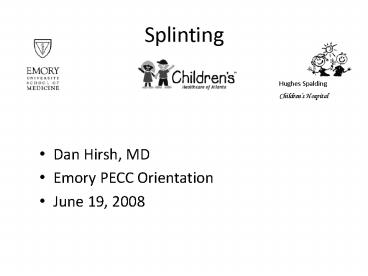Splinting - PowerPoint PPT Presentation
1 / 31
Title:
Splinting
Description:
Title: Splinting Author: Daniel Hirsh Last modified by: Daniel Hirsh Document presentation format: On-screen Show (4:3) Other titles: Gill Sans ... – PowerPoint PPT presentation
Number of Views:71
Avg rating:3.0/5.0
Title: Splinting
1
Splinting
Hughes Spalding Childrens Hospital
- Dan Hirsh, MD
- Emory PECC Orientation
- June 19, 2008
2
A splint is a non-circumferential immobilization
device to treat fractures, lacerations of skin or
tendon, and sprains.
3
(No Transcript)
4
(No Transcript)
5
(No Transcript)
6
(No Transcript)
7
(No Transcript)
8
(No Transcript)
9
(No Transcript)
10
Complications Prevention
Risk of ischemia Compartment Syndrome Possible neurovascular compromise Keep splint snug Check distal neurovascular status after placement
Skin breakdown Keep splint dry Use minimal water necessary and dry thoroughly before placement Use padding Avoid kinks
Pain or Ineffective Immobilization Check splint after placement If either of these too, replace the splint
11
Tell patients and family that
- Splint material will get warm when it
hardensFiberglass cures in 15 minutes with
ambient humidity5 minutes with cold water1
minute with warm water - Should be snug, not tight (fingers shouldnt
tingle)
12
Stockinette
Ace wrap
Webril / wadding
13
Optional Apply stockinet to extremity Extend it
past the proximal and distal ends of where the
splint will end Cut out any areas that bunch up
that could damage the skin Create thumb hole
14
(No Transcript)
15
(No Transcript)
16
Use cold water May use NO water, just ambient
humidity (this will take much longer to harden)
Hot water will cause the fiberglass to harden
very quickly
If you use water, keep padding as dry as possible
17
Protect the skin. If cotton padding is wet, dry
it.
18
Some fiberglass material comes with a thick
padded side and a thin side. Protect the skin.
Always place the thick-side to the skin-side.
19
Wrap the splint in placenot too loose or too
tight. Protect the skin. Do not apply pressure
with finger tips, use a curved palm.
20
Keep joint in a protective position. Keep hand
slightly extended at the wrist, thumb-up,
fingers curved around an object
21
Discharge Instructions
- Make sure neurovascular intact in not pain from
splint - Elevate, ice rest injured extremity
- Keep splint dry
- Splints are non/partial weight bearing, use
crutches - If fingers become tingly or blue, re-wrap the
bandage - If splint hurts, or there is increasing pain,
TAKE THE SPLINT OFF! Seek medical attention
22
- Posterior Arm
- Used for stable elbow injuries
- Width ½ arm circumference
- Length dorsal aspect of mid-upper arm down ulnar
side to distal palmer flexion crease
23
- Sugar Tong
- Can be applied both proximally or distally or
both at the same time - When in doubt, use the sugar tong
- Width slightly overlap radial and ulnar edges of
arm - Length dorsal aspect of knuckles around elbow to
volar palmer flexion crease - Can place patient prone for easy installation
- Must keep arm in 90 flexion
- Dont let the splint slide up or down
24
- Gutter
- Metacarpal and/or proximal phalnageal fractures
- Ulnar immobilizes 5th 4th digits, radial 2nd
3rd - Width wrap to midline of hand on dorsal and
volar surfaces - Length nail base to proximal forearm
25
- Volar
- Distal forearm or wrist fractures
- Dont use in small children
- Width fully cover volar aspect of forearm
- Length from proximal fingers to proximal forearm
26
- Thumb Spica
- Non-displaced fractures of 1st metacarpal bone,
proximal phalanx of thumb, scaphoid fracture - Length nail base to proximal forearm
27
- Posterior Leg
- Distal Tibia and/or fibula injuries, ankle, foot
- Width at least ½ leg circumference, but
NON-circumferential - Length level of fibular neck to base of digits
- Shape splint into neutral position, 90 flexion
- These are partial/non weight bearing splints
28
- Buddy Tape
- Padded metal strip may go dorsal or volar
29
- Stirrup
- Provides lateral support, may use with Posterior
Leg splint for added stability (aka Cadillac
Splint) - Width at least ½ leg circumference, but
NON-circumferential - Length level of fibular head around heel and
back up the leg - Shape splint into neutral position, 90 flexion
- These are partial/non weight bearing splints
30
(No Transcript)
31
Sugar Tong Stirrup
Long Arm Short Posterior leg
Thumb Spica
Volar































